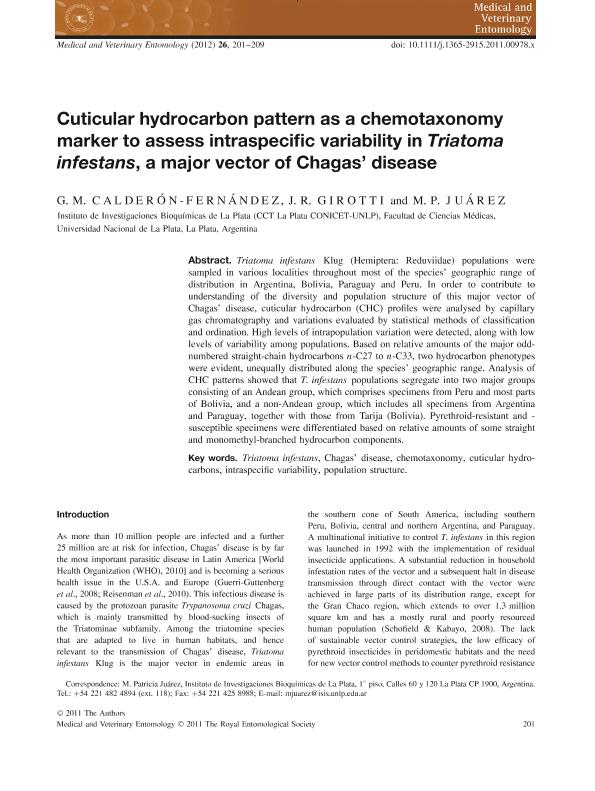Artículo
Cuticular hydrocarbon pattern as a chemotaxonomy marker to assess intraspecific variability in Triatoma infestans, a major vector of Chagas' disease
Fecha de publicación:
06/2012
Editorial:
Wiley Blackwell Publishing, Inc
Revista:
Medical and Veterinary Entomology
ISSN:
0269-283X
Idioma:
Inglés
Tipo de recurso:
Artículo publicado
Clasificación temática:
Resumen
Triatoma infestans Klug (Hemiptera: Reduviidae) populations were sampled in various localities throughout most of the species' geographic range of distribution in Argentina, Bolivia, Paraguay and Peru. In order to contribute to understanding of the diversity and population structure of this major vector of Chagas' disease, cuticular hydrocarbon (CHC) profiles were analysed by capillary gas chromatography and variations evaluated by statistical methods of classification and ordination. High levels of intrapopulation variation were detected, along with low levels of variability among populations. Based on relative amounts of the major odd-numbered straight-chain hydrocarbons n-C27 to n-C33, two hydrocarbon phenotypes were evident, unequally distributed along the species' geographic range. Analysis of CHC patterns showed that T. infestans populations segregate into two major groups consisting of an Andean group, which comprises specimens from Peru and most parts of Bolivia, and a non-Andean group, which includes all specimens from Argentina and Paraguay, together with those from Tarija (Bolivia). Pyrethroid-resistant and -susceptible specimens were differentiated based on relative amounts of some straight and monomethyl-branched hydrocarbon components.
Archivos asociados
Licencia
Identificadores
Colecciones
Articulos(INIBIOLP)
Articulos de INST.DE INVEST.BIOQUIMICAS DE LA PLATA
Articulos de INST.DE INVEST.BIOQUIMICAS DE LA PLATA
Citación
Calderón Fernández, Gustavo Mario; Girotti, Juan Roberto; Juarez, Marta Patricia; Cuticular hydrocarbon pattern as a chemotaxonomy marker to assess intraspecific variability in Triatoma infestans, a major vector of Chagas' disease; Wiley Blackwell Publishing, Inc; Medical and Veterinary Entomology; 26; 2; 6-2012; 201-209
Compartir
Altmétricas




